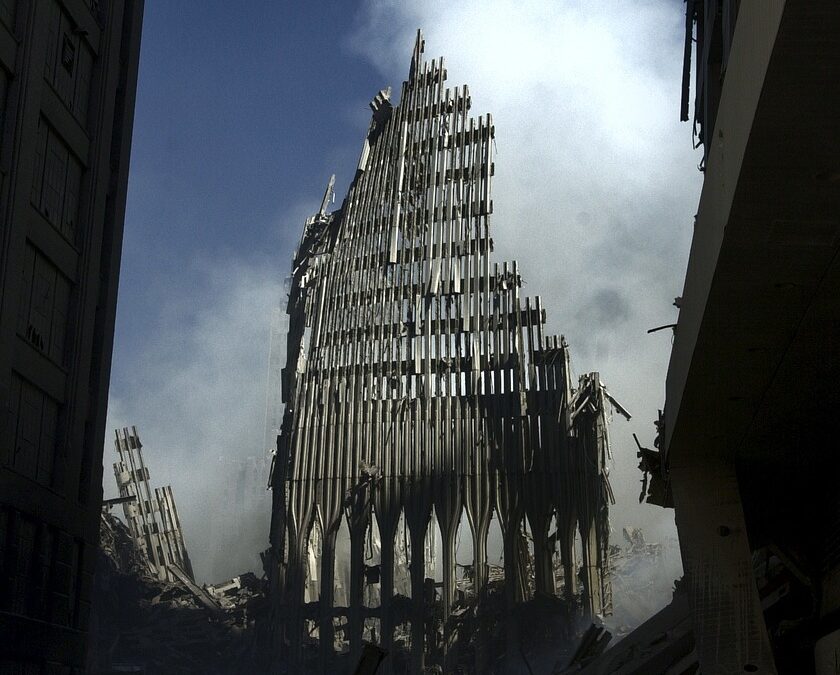If you were young at the time of the 9/11 attack, you might not remember the sense of panic that swept the country immediately afterward.
If terrorists could simultaneously hijack four airliners, reduce two of the largest buildings in the world to rubble, and inflict major damage to the Pentagon, what couldn’t they do?
Would more planes be hijacked and crashed? Nobody knew, but the FAA grounded all air traffic so that the only non-military plane in the sky was the one carrying President George Bush to … well, at the time nobody knew the plane’s destination. Washington wasn’t safe and neither was New York. It seemed like the terrorists could strike anywhere they pleased with impunity.
And who knew what type of weapons they might employ next! There was much speculation that future attacks would include chemical and even biological weapons, and this fear led to a sudden jump in sales of respirator-type face masks. Others speculated that electromagnetic pulse weapons could be launched from offshore submarines
Abiding Fear
Despite reassurances from media and the government, a lower-level fear persisted for a long time afterwards. A couple of years after 9/11 I was invited to give a talk at the King’s College, which at the time happened to be located in the Empire State Building — a place which, in my mind, would be the next logical target for terrorists seeking to bring down an iconic building in the middle of New York City.
Although my talk had nothing to do with Islam, I admit to feeling more than a little nervous about flying from Boston to New York (as the hijackers had) and then delivering a lecture with one eye on my notes and the other scanning the skyline for signs of a low-flying jet plane heading in our direction.
One of the little-noted effects of the 9/11 attacks was that they created an anticipation that the next attack also would be a large-scale event of historic proportions. We were scanning the skyline for something big — but when something big didn’t happen, we eventually let our guard down. If we overreacted to 9/11, we under-reacted to subsequent terror attacks because they paled in comparison to the Pearl Harbor-like impact of the attacks on New York and Washington.
Asleep Again
9/11 was one of the biggest wake-up calls in history. And we did wake up … for a while. But when the anticipated large-scale follow-up attacks didn’t materialize, we rolled over and went back to sleep — oblivious to the fact that, over the long run, other forms of jihad could be just as effective as the explosive variety.
There was good cause to worry in the weeks and months following 9/11. It would have been foolish not to worry. The irony is that now, 24 years later, there is much more reason to worry about Islamic jihad, yet fewer Americans seem to be alarmed by that possibility.
Why worry now? Because there are far more jihad attacks worldwide than there were in 2001. For example, every year in Nigeria, twice as many people die in jihad attacks as were killed on 9/11.
But violence is not the preferred method of spreading Islam. One of the things that radical Islamists learned from 9/11 is that, although violent attacks captured attention, they could bring too much unwanted attention — the kind that sent Osama Bin Ladin fleeing for his life through the caves and mountains of Afghanistan.
As a result, many jihadists developed a preference for more subtle forms of jihad — so subtle that their enemies (us) were happy to collaborate in programs and projects aimed at their own destruction.
Roofies At Work
Astute observers dubbed this quieter, less obtrusive form “stealth jihad.” Although large-scale jihad did not entirely disappear, the emphasis shifted. Instead of incinerating cultural and political institutions, the jihadists would infiltrate them and “turn” them in a pro-Islam direction.
“Stealth jihad”? That term is a bit misleading. Much of it has not been particularly stealthy. Thanks to the trusting nature of Americans, it didn’t need to be. A better description is “cultural jihad.” The cultural jihadists seek large-scale changes but they don’t go about it in cloak-and-dagger fashion. A prime example is the decades-long operation by Arab nations to influence and subvert American universities.
For example, Qatar donated over $1.95 billion to Cornell University between 2001 and 2023. That’s thirty times more than the next largest donor, Hong Kong. Moreover, Qatar has donated more than a billion dollars to Texas A & M University for a project that would have given Qatar access to nuclear energy research. (Texas A & M recently announced that it will close its program in Qatar.) Qatar has also poured millions of dollars into Harvard, Yale, Carnegie Mellon, Georgetown, and other elite universities.
In addition, Qatar has taken an interest in the younger segment of U.S. students. For many years it has funded the Choices Program, a K-12 social studies program hosted by Brown University that reaches more than a million students. More than 8,000 schools use the Choices curriculum. However, Brown recently cut its ties with the Choices Program following claims that it presented a distorted view of Middle Eastern history. Undoubtedly, the Brown administration was shocked by the revelation.
Why has Qatar been so generous to already wealthy American universities? The answer, of course, is that the sheiks are trying to buy influence. They are looking for a chance to shape the way young people think about issues in the Middle East — and, beyond that, for ways to weaken students’ attachment to Western culture and values.
Has it worked? No matter how you view the Hamas-Israeli conflict, you must have noticed how quickly anti-Israel, pro-Palestinian rallies and sit-ins sprang up on college campuses nationwide. Suddenly, students whose main interests before that were betting on sports and drinking beer were chanting “from the river to the sea” and other pro-Palestine slogans. It seemed spontaneous, but in large part it was the result of exposure to years of cultural jihad on campus.
On 9/11, violent jihadists hijacked four passenger jets. In the years following, more patient and methodical jihadists hijacked higher education.
Tomorrow, we will look at an even more ominous hijacking and the strategies used to pull it off.
This article originally appeared in the June 4, 2025 edition of The Stream.
Photo credit: Pixabay


